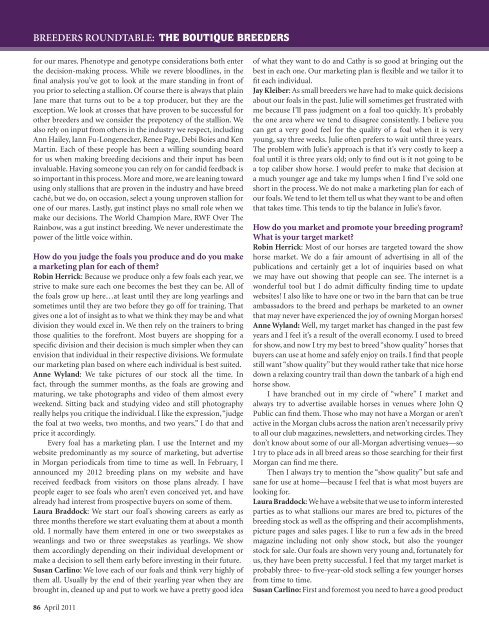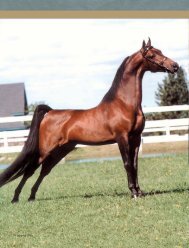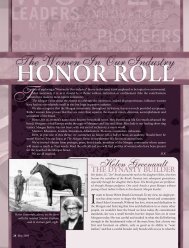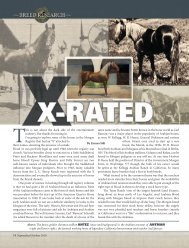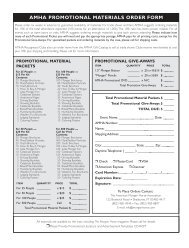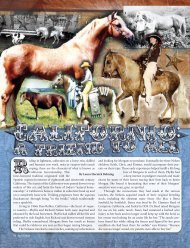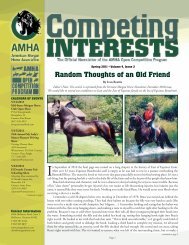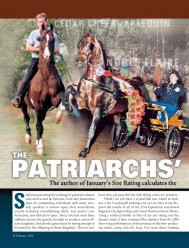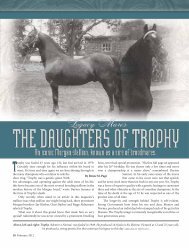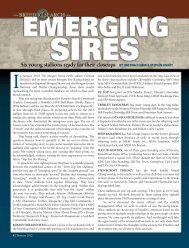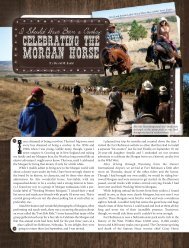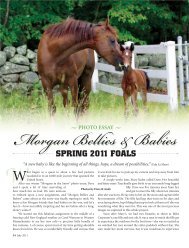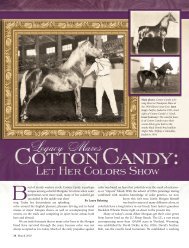Create successful ePaper yourself
Turn your PDF publications into a flip-book with our unique Google optimized e-Paper software.
BREEDERS ROUNDTABLE: The <strong>Boutique</strong> <strong>Breeders</strong><br />
for our mares. Phenotype and genotype considerations both enter<br />
the decision-making process. While we revere bloodlines, in the<br />
final analysis you’ve got to look at the mare standing in front of<br />
you prior to selecting a stallion. Of course there is always that plain<br />
Jane mare that turns out to be a top producer, but they are the<br />
exception. We look at crosses that have proven to be successful for<br />
other breeders and we consider the prepotency of the stallion. We<br />
also rely on input from others in the industry we respect, including<br />
Ann Hailey, Iann Fu-Longenecker, Renee Page, Debi Boies and Ken<br />
Martin. Each of these people has been a willing sounding board<br />
for us when making breeding decisions and their input has been<br />
invaluable. Having someone you can rely on for candid feedback is<br />
so important in this process. More and more, we are leaning toward<br />
using only stallions that are proven in the industry and have breed<br />
caché, but we do, on occasion, select a young unproven stallion for<br />
one of our mares. Lastly, gut instinct plays no small role when we<br />
make our decisions. The World Champion Mare, RWF Over The<br />
Rainbow, was a gut instinct breeding. We never underestimate the<br />
power of the little voice within.<br />
How do you judge the foals you produce and do you make<br />
a marketing plan for each of them<br />
Robin Herrick: Because we produce only a few foals each year, we<br />
strive to make sure each one becomes the best they can be. All of<br />
the foals grow up here…at least until they are long yearlings and<br />
sometimes until they are two before they go off for training. That<br />
gives one a lot of insight as to what we think they may be and what<br />
division they would excel in. We then rely on the trainers to bring<br />
those qualities to the forefront. Most buyers are shopping for a<br />
specific division and their decision is much simpler when they can<br />
envision that individual in their respective divisions. We formulate<br />
our marketing plan based on where each individual is best suited.<br />
Anne Wyland: We take pictures of our stock all the time. In<br />
fact, through the summer months, as the foals are growing and<br />
maturing, we take photographs and video of them almost every<br />
weekend. Sitting back and studying video and still photography<br />
really helps you critique the individual. I like the expression, “judge<br />
the foal at two weeks, two months, and two years.” I do that and<br />
price it accordingly.<br />
Every foal has a marketing plan. I use the Internet and my<br />
website predominantly as my source of marketing, but advertise<br />
in Morgan periodicals from time to time as well. In February, I<br />
announced my 2012 breeding plans on my website and have<br />
received feedback from visitors on those plans already. I have<br />
people eager to see foals who aren’t even conceived yet, and have<br />
already had interest from prospective buyers on some of them.<br />
Laura Braddock: We start our foal’s showing careers as early as<br />
three months therefore we start evaluating them at about a month<br />
old. I normally have them entered in one or two sweepstakes as<br />
weanlings and two or three sweepstakes as yearlings. We show<br />
them accordingly depending on their individual development or<br />
make a decision to sell them early before investing in their future.<br />
Susan Carlino: We love each of our foals and think very highly of<br />
them all. Usually by the end of their yearling year when they are<br />
brought in, cleaned up and put to work we have a pretty good idea<br />
of what they want to do and Cathy is so good at bringing out the<br />
best in each one. Our marketing plan is flexible and we tailor it to<br />
fit each individual.<br />
Jay Kleiber: As small breeders we have had to make quick decisions<br />
about our foals in the past. Julie will sometimes get frustrated with<br />
me because I’ll pass judgment on a foal too quickly. It’s probably<br />
the one area where we tend to disagree consistently. I believe you<br />
can get a very good feel for the quality of a foal when it is very<br />
young, say three weeks. Julie often prefers to wait until three years.<br />
The problem with Julie’s approach is that it’s very costly to keep a<br />
foal until it is three years old; only to find out is it not going to be<br />
a top caliber show horse. I would prefer to make that decision at<br />
a much younger age and take my lumps when I find I’ve sold one<br />
short in the process. We do not make a marketing plan for each of<br />
our foals. We tend to let them tell us what they want to be and often<br />
that takes time. This tends to tip the balance in Julie’s favor.<br />
How do you market and promote your breeding program<br />
What is your target market<br />
Robin Herrick: Most of our horses are targeted toward the show<br />
horse market. We do a fair amount of advertising in all of the<br />
publications and certainly get a lot of inquiries based on what<br />
we may have out showing that people can see. The internet is a<br />
wonderful tool but I do admit difficulty finding time to update<br />
websites! I also like to have one or two in the barn that can be true<br />
ambassadors to the breed and perhaps be marketed to an owner<br />
that may never have experienced the joy of owning Morgan horses!<br />
Anne Wyland: Well, my target market has changed in the past few<br />
years and I feel it’s a result of the overall economy. I used to breed<br />
for show, and now I try my best to breed “show quality” horses that<br />
buyers can use at home and safely enjoy on trails. I find that people<br />
still want “show quality” but they would rather take that nice horse<br />
down a relaxing country trail than down the tanbark of a high end<br />
horse show.<br />
I have branched out in my circle of “where” I market and<br />
always try to advertise available horses in venues where John Q<br />
Public can find them. Those who may not have a Morgan or aren’t<br />
active in the Morgan clubs across the nation aren’t necessarily privy<br />
to all our club magazines, newsletters, and networking circles. They<br />
don’t know about some of our all-Morgan advertising venues—so<br />
I try to place ads in all breed areas so those searching for their first<br />
Morgan can find me there.<br />
Then I always try to mention the “show quality” but safe and<br />
sane for use at home—because I feel that is what most buyers are<br />
looking for.<br />
Laura Braddock: We have a website that we use to inform interested<br />
parties as to what stallions our mares are bred to, pictures of the<br />
breeding stock as well as the offspring and their accomplishments,<br />
picture pages and sales pages. I like to run a few ads in the breed<br />
magazine including not only show stock, but also the younger<br />
stock for sale. Our foals are shown very young and, fortunately for<br />
us, they have been pretty successful. I feel that my target market is<br />
probably three- to five-year-old stock selling a few younger horses<br />
from time to time.<br />
Susan Carlino: First and foremost you need to have a good product<br />
86 April 2011


